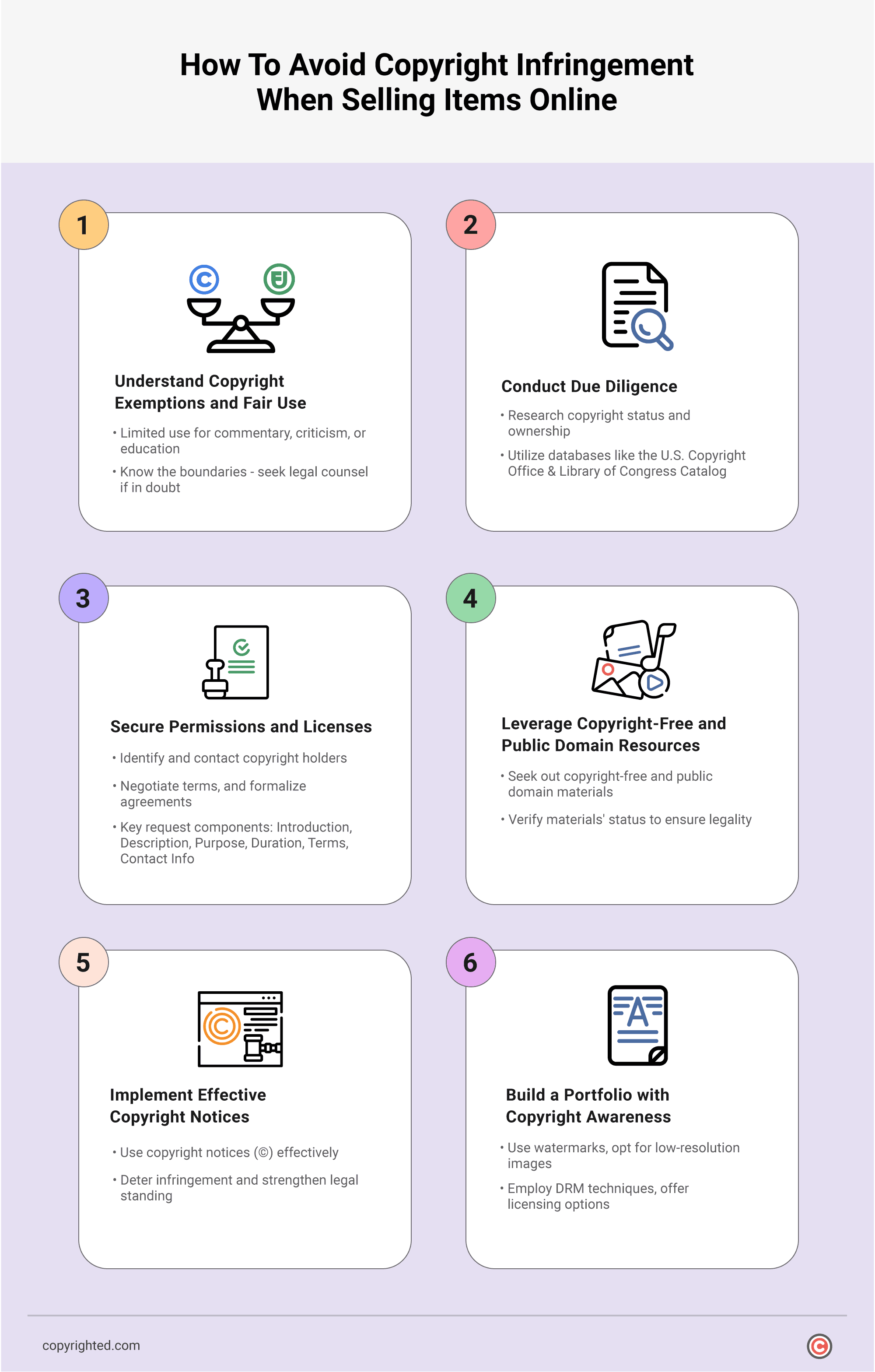Copyright law protects individuals’ creative works and ensures that their rights are upheld in an increasingly digital world. However, the ease of online commerce has made it tempting for some to disregard these laws, potentially leading to copyright infringement.
Your products might unknowingly violate copyright law, posing legal risks and jeopardizing your business. Read on if you’re keen on maintaining legal compliance and protecting your online venture.
In this article, we’ll explore strategies for avoiding copyright infringement when selling items online, exploring factors contributing to infringement, and discussing the potential risks associated with copyright issues in online commerce.
- Before incorporating any material into your work, you must conduct due diligence to ensure you’re not infringing on someone else’s copyright.
- To avoid copyright issues altogether, you can utilize copyright-free and public-domain resources.
- You cannot sell copyrighted items without permission from the copyright holder.
Table of Contents
6 Tips On How You Can Avoid Copyright Infringement When Selling Items Online
Copyright is a fundamental aspect of the creative industry, protecting the rights of creators and their works. However, copyright laws can be complex, especially in the digital age where content can be easily shared and reproduced.
Several key strategies can be employed to help creators avoid copyright infringement when selling items online.

1. Understand Copyright Exemptions and Fair Use
Copyright exemptions and fair use provide important guidelines for creators regarding the use of copyrighted material. Fair use allows for limited use of copyrighted material without permission for purposes such as commentary, criticism, or education.
However, it’s essential to grasp the limitations of fair use. Seek legal counsel if uncertain about fair use protection for your work, as grasping these exemptions aids in discerning the delicate balance between inspiration and infringement.
2. Conduct Due Diligence
Before incorporating any material into your work, you must conduct due diligence to ensure you’re not infringing on someone else’s copyright. This involves researching the copyright status of the material and verifying its ownership.
Official databases and copyright registries are valuable resources for this purpose, providing you with reliable information to make informed decisions.
Here are some examples of such resources:
- United States Copyright Office: The U.S. Copyright Office maintains an extensive database of registered copyrights. Creators can search this database to verify the copyright status of works and identify their owners.
- Library of Congress Catalog: The Library of Congress catalog contains records for millions of books, periodicals, sound recordings, and other copyrighted materials. It can be a valuable resource for identifying copyrighted works and their copyright holders.
3. Secure Permissions and Licenses
The process of obtaining permissions and licenses for copyrighted material involves several key steps. Firstly, you need to identify the copyright holder, which could be the creator or a publishing company.
Next, contact the copyright holder to request permission, specifying how you intend to use the material. Negotiate licensing terms, including fees and usage details, and draft a formal licensing agreement outlining the rights granted.
Finally, you need to review the agreement carefully, seeking legal advice if necessary, before obtaining written permission from the copyright holder to use the material as agreed upon. This ensures legal authorization and protection of your interests.
When drafting a licensing request, consider including the following key points:
- Introduction: Introduce yourself and provide information about your organization or project.
- Description of Material: Clearly identify the copyrighted material you wish to use, including title, author/creator, and any relevant details.
- Purpose of Use: Explain how you intend to use the material and why you believe it falls within the scope of fair use or requires licensing.
- Duration and Scope: Specify the duration of use and the scope of rights you are requesting, including any specific formats or mediums.
- Proposed Terms: Provide initial suggestions for licensing terms, including any proposed fees or royalties.
- Contact Information: Include your contact information for further discussion and negotiation.
4. Leverage Copyright-Free and Public Domain Resources
To avoid copyright issues altogether, you can utilize copyright-free and public-domain resources. These materials are not subject to copyright restrictions and can be used freely in your creative works.
However, verifying that the materials are copyright-free or in the public domain is important to avoid inadvertently using protected content.
You can access copyright-free and public-domain materials from sources like Creative Commons and government websites. Ensure legality by verifying materials’ status through clear public domain statements and reviewing associated terms of use, enabling the incorporation of high-quality content into works without the risk of copyright infringement.
5. Implement Effective Copyright Notices
Implementing effective copyright notices involves marking creations with the appropriate copyright symbol (©), the year of creation, and the copyright owner’s name. The notice should be placed prominently on the work, such as at the bottom of a webpage, on the title page of a document, or in the credits of a video.
By doing so, you can assert ownership of the work and notify others that it is protected by copyright. This can deter infringement by informing potential infringers of the legal consequences of unauthorized use.
Additionally, including a copyright notice strengthens your legal standing in the event of infringement disputes, as it serves as evidence of ownership and can help establish willful infringement by others.
6. Build a Portfolio with Copyright Awareness
When building a portfolio, creators must showcase their original work while respecting copyright laws. By employing various strategies, you can protect your intellectual property while still sharing your creations effectively. Let’s take a look at some of these strategies:
- Utilize Watermarks: Adding subtle watermarks to images or documents can discourage unauthorized use by asserting copyright ownership. Incorporate your name, logo, or copyright symbol strategically to minimize interference while remaining visible.
- Opt for Low-Resolution Images: When showcasing your work online, use low-resolution images to balance accessibility with protection against unauthorized copying or printing, allowing viewers to appreciate content without compromising quality.
- Employ DRM Techniques: Use Digital Rights Management methods to control digital content access and prevent unauthorized distribution or copying. This involves encrypting files, implementing access controls, or embedding digital signatures to authenticate ownership.
- Provide Clear Copyright Information: Include copyright symbols, creation year, and creator’s name alongside showcased work to reinforce ownership and inform viewers of associated legal protections.
- Offer Licensing Options: Provide licensing choices for others to legally use your work legally, allowing controlled usage while generating revenue and respecting copyright laws.
Determine Factors for Copyright Infringement in Your Products
As creators, protecting intellectual property rights is a legal necessity and a fundamental aspect of ethical practice in the creative industry. This is why it’s important to grasp the factors influencing infringement determinations.
Here, we explore the key factors influencing copyright infringement assessments, helping you make informed decisions to protect your work.
Nature of the Copyrighted Work
Works that are more creative or original, such as novels, music compositions, or artistic creations, receive stronger protection under copyright law than factual or non-fictional works. Utilizing highly creative or original content without permission increases the likelihood of infringement.
Amount and Substantiality of the Portion Used
Using a substantial portion of a copyrighted work without permission can constitute infringement, regardless of the proportion of the whole work.
While there is no specific threshold for what constitutes a substantial portion, factors such as the significance of the portion used in relation to the entire work and the qualitative importance of the copied material are considered. Even using small but critical parts of a work may lead to infringement.
Purpose and Character of the Use
The purpose and character of the use refer to how the copyrighted material is utilized in the product.
If the use is transformative, such as for commentary, criticism, or parody, it may be considered fair use and not infringing. However, if the use is commercial or involves copying the material verbatim without adding a new expression or meaning, it is less likely to be considered fair use and may constitute infringement.
Effect of the Use on the Potential Market
The effect of the use on the potential market for copyrighted work is another important factor in determining infringement.
If the unauthorized use of the copyrighted material diminishes the market value or potential sales of the original work, it is more likely to be considered infringement. Conversely, if the use does not compete with or harm the market for the original work, it may be more likely to be considered fair use.
By carefully considering these factors, you can assess the risk of copyright infringement when developing products and take appropriate measures to protect against legal liabilities while respecting the rights of copyright holders.
It’s also wise to be aware of copyright infringement scams, where deceptive actors may falsely accuse sellers of violations to demand payments or obtain unauthorized access to personal or business data.
What Are the Risks of Copyright Infringement When Selling Items?
When selling items, creators face significant risks associated with copyright infringement, which can seriously affect their business and reputation.
You need to understand these risks to effectively manage your presence in the marketplace and protect your interests. Here are some key considerations:
- Damage to Professional Reputation: Being found liable for copyright infringement can tarnish your professional reputation. Negative publicity and perceptions of unethical behaviour can dissuade potential customers and business partners, impacting future opportunities and collaborations.
- Loss of Sales and Revenue: Infringing on copyrighted material can lead to loss of sales and revenue. Legal actions, negative publicity, and damage to reputation may stop customers from purchasing products, leading to a decline in sales and financial losses.
- Blocking of Distribution Channels: Copyright infringement can lead to blocking or suspension of distribution channels, as online marketplaces, retailers, or distributors may decline to carry infringing products, thereby constraining creators’ capacity to reach customers and generate revenue. For example, if you’re an Etsy seller, you need to be aware of Etsy’s copyright infringement guidelines to ensure that your listings do not violate copyright laws. Additionally, when using assets from copyright infringement third parties, such as freelancers or outsourced designers—always verify that the content provided does not violate any existing rights, as liability may still fall on you as the seller.
- Seizure of Infringing Products: In severe cases of copyright infringement, authorities may seize infringing products, leading to the loss of inventory and further financial setbacks. This can disrupt business operations and result in significant losses for creators.
Frequently Asked Questions
Can you sell things that are copyrighted?
Generally, you cannot sell copyrighted items without permission from the copyright holder. Doing so would likely constitute copyright infringement, which can lead to legal consequences.
Can you sell merchandise without copyright?
Yes, you can sell merchandise that is not protected by copyright, such as original artwork, handmade crafts, or generic products. However, it’s important to ensure that your products do not infringe on others’ copyrights.
Is it legal to sell inspired items?
Selling “inspired” items can be legally complex. While taking inspiration from existing designs or concepts is common in the creative industry, directly copying or imitating copyrighted material without permission can constitute copyright infringement.
Is reselling copyrighted material illegal?
In most cases, reselling copyrighted material without permission from the copyright holder is illegal and constitutes copyright infringement. This applies to both physical and digital goods. However, exceptions exist, such as the first-sale doctrine, which allows the resale of lawfully acquired copyrighted works under certain conditions.
Can you sell stuff without being a business?
Yes, you can sell items without being a registered business. Many individuals sell items as a hobby or for extra income without formalizing their activities as a business. However, it’s important to comply with relevant laws including tax and copyright laws, regardless of whether you operate as a business or as an individual seller.


